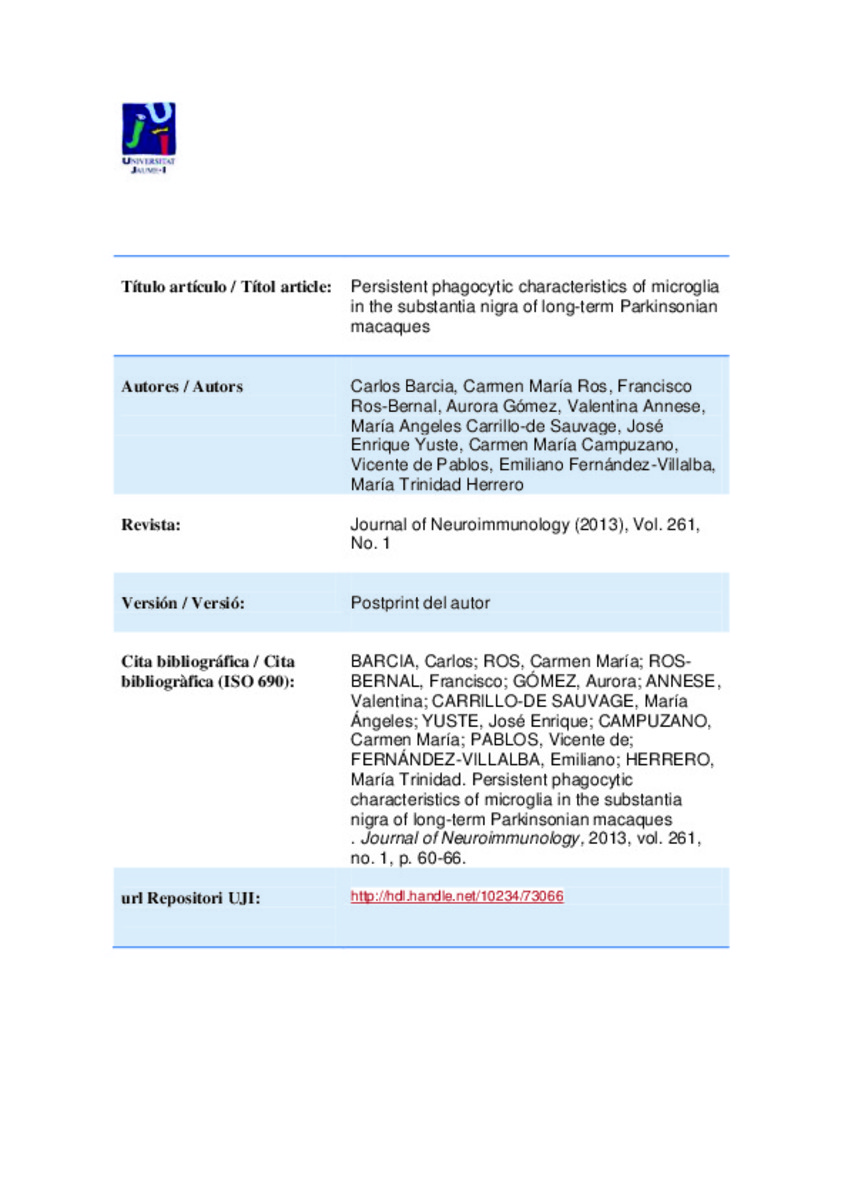Mostrar el registro sencillo del ítem
Persistent phagocytic characteristics of microglia in the substantia nigra of long-term Parkinsonian macaques
| dc.contributor.author | Barcia, Carlos | |
| dc.contributor.author | Ros Gómez, Carmen María | |
| dc.contributor.author | Ros Bernal, Francisco | |
| dc.contributor.author | Gómez, Aurora | |
| dc.contributor.author | Annese, Valentina | |
| dc.contributor.author | Carrillo-de Sauvage, María Ángeles | |
| dc.contributor.author | Yuste Jiménez, José Enrique | |
| dc.contributor.author | Campuzano Brando, Carmen María | |
| dc.contributor.author | De Pablos, Vicente | |
| dc.contributor.author | Fernández Villalba, Emiliano | |
| dc.contributor.author | Herrero Ezquerro, María Trinidad | |
| dc.date.accessioned | 2013-09-20T14:27:32Z | |
| dc.date.available | 2013-09-20T14:27:32Z | |
| dc.date.issued | 2013 | |
| dc.identifier.citation | Journal of Neuroimmunology Volume 261, Issue 1 , Pages 60-66, 15 August 2013 | ca_CA |
| dc.identifier.issn | 0165-5728 | |
| dc.identifier.issn | 1872-8421 | |
| dc.identifier.uri | http://hdl.handle.net/10234/73066 | |
| dc.description.abstract | Patients with Parkinson's disease show persistent microglial activation in the areas of the brain where the degeneration of dopaminergic neurons takes place. The reason for maintaining this activated state is still unknown, but it is thought that this persistent microglial activation may contribute to the degeneration of dopaminergic neurons. In this study, we report the microanatomical details of microglia and the relationship between microglia and neurons in the substantia nigra pars compacta of Parkinsonian monkeys years after insult with MPTP. We observed that microglial cells appear polarized toward dopaminergic neurons in MPTP-treated macaques compared to untreated animals and present clear phagocytic characteristics, such as engulfing gliaptic contacts, an increase in Golgi apparatus protein machinery and ball-and-chain phagocytic buds. These results demonstrate that activated microglia maintain phagocytic characteristics years after neurotoxin insult, and phagocytosis may be a key contributor to the neurodegenerative process. | ca_CA |
| dc.format.extent | 6 p. | ca_CA |
| dc.format.mimetype | application/pdf | ca_CA |
| dc.language.iso | eng | ca_CA |
| dc.publisher | Elsevier | ca_CA |
| dc.relation.isPartOf | Journal of Neuroimmunology, 2013, Vol. 261, Num. 1 | ca_CA |
| dc.rights | Copyright © 2013 Elsevier Inc. All rights reserved.This is the author’s version of a work that was accepted for publication in Journal of Neuroimmunology. Changes resulting from the publishing process, such as peer review, editing, corrections, structural formatting, and other quality control mechanisms may not be reflected in this document. Changes may have been made to this work since it was submitted for publication. A definitive version was subsequently published in Journal of Neuroimmunology Volume 261, Issue 1 , Pages 60-66, 15 August 2013 DOI10.1016/j.jneuroim.2014.05.001 | ca_CA |
| dc.rights.uri | http://rightsstatements.org/vocab/InC/1.0/ | * |
| dc.subject | Parkinson's disease | ca_CA |
| dc.subject | MPTP | ca_CA |
| dc.subject | Dopaminergic degeneration | ca_CA |
| dc.subject | Cell polarity | ca_CA |
| dc.subject | Inflammation | ca_CA |
| dc.subject | Microglial motility | ca_CA |
| dc.title | Persistent phagocytic characteristics of microglia in the substantia nigra of long-term Parkinsonian macaques | ca_CA |
| dc.type | info:eu-repo/semantics/article | ca_CA |
| dc.identifier.doi | http://dx.doi.org/10.1016/j.jneuroim.2013.05.001 | |
| dc.rights.accessRights | info:eu-repo/semantics/openAccess | ca_CA |
| dc.relation.publisherVersion | http://www.jni-journal.com/article/S0165-5728(13)00133-1/abstract | ca_CA |
| dc.type.version | info:eu-repo/semantics/acceptedVersion |
Ficheros en el ítem
Este ítem aparece en la(s) siguiente(s) colección(ones)
-
MED_Articles [641]
Articles de publicacions periòdiques







